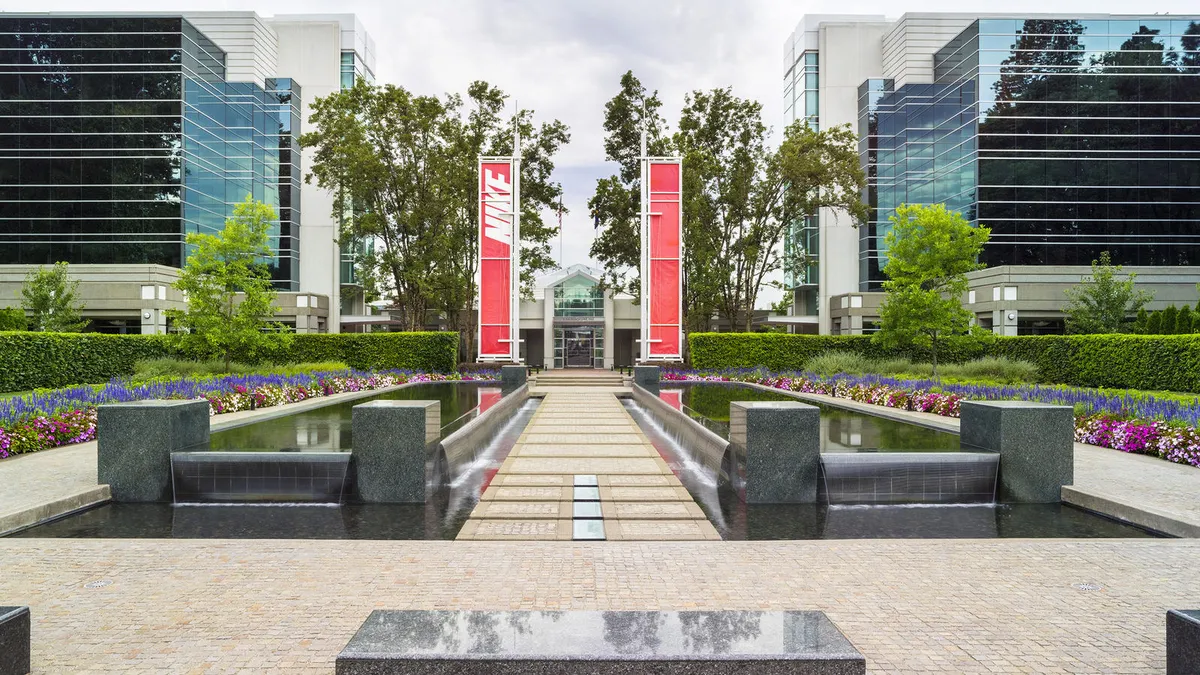As Armageddons go, the retail apocalypse is turning out to be short-lived. After a few years of headlines blaring about devastation and the scourge of e-commerce for physical stores, retailers in recent quarters are posting healthy comps and increases in foot traffic.
"The term 'retail apocalypse' has been misused for years," said Michael Brown, partner in the retail practice of global strategy and management consultancy A.T. Kearney and author of the report The Future of Shopping Centers. "Throughout the whole shifting dynamic in retail, the one thing that has never changed is the need to have compelling goods and services offered with convenience and a price people are willing to pay. Retail, in general, is not a physical or digital world."
And retail generally appears to be on the rebound. Retail comp sales in the second quarter were up 4.2% year over year (4% excluding retail giant Walmart), the highest level since 2007, according to a Retail Metrics report emailed to Retail Dive, which noted that 19 retailers to date have reported negative Q2 comps, "down dramatically from Q1 when 38 chain[s] turned in negative same store sales and 1Q17 when 60 companies did so."
It's still not a pretty picture on the ground, however. Second quarter mall rents fell 4.6% from the first quarter and 7.1% year over year, hit by major store closures from Toys R Us, Sears and J.C. Penney, according to a trend report from commercial real estate firm JLL. Mall vacancy rates hit 4% during the period, JLL said. The retail sector suffered its worst quarter in nine years with net absorption of negative 3.8 million square feet, which pushed the regional mall vacancy rate up by 0.2% to 8.6% as the average mall rent increased 0.3%, according to another report from commercial real estate firm Reis emailed to Retail Dive.
"We're working through a number of the bankruptcies and replacing them with better retailers."

David Simon
CEO of Simon Property Group, Inc.
All in all, retail consolidation will continue to make headlines in 2018, but regional mall defaults are unlikely to reach the levels seen last year, according to Morningstar Credit Ratings, LLC. That's partly because so many big store closure plans (like Macy's, Toys' and J.C. Penney's) will have been mostly executed. Plus, shopping centers are filling their vacancies, though often with non-retail tenants. Architect Stan Laegreid, a principal at Field Paoli Architects and the designer of several high-end malls, says we'll soon notice that new mall designs will increasingly be hospitality, rather than retail focused, from the jump.
But it's also because the remaining chains are doing better, as they've overhauled both stores and merchandise, in part with proceeds from last year's tax windfall.
"A number of our retailers are getting better and healthier. And I think the tax cut on their business gave them more earnings to invest or replenish their merchandise," David Simon, CEO of Simon Property Group, Inc. told analysts in July, according to a transcript from Seeking Alpha. "We're working through a number of the bankruptcies and replacing them with better retailers. We're upgrading our mix, so you put it all together and I think that's what's generated at least the increase in sales."
Is it e-commerce?
As thousands of U.S. stores have shuttered in recent years, falling sales were being attributed to everything from bad weather to a still-hesitant consumer, yet e-commerce kept humming. It's a two-fer that's led to store closures and tactical shifts.
Toys R Us threw in the towel, Macy's contracted its massive footprint, and Sears and J.C. Penney have struggled, and all that precipitated significant store closures. Legacy retailers, meanwhile — department stores like Macy's, mass merchants like Target and specialty retailers like Best Buy and teen apparel chains — have all turned their attention to boosting digital sales.
Walmart has demonstrated the most dramatic shift in focus, scaling back store openings in previous years as it bought up online outdoor retailer Moosejaw for $51 million in cash, vintage-inspired online women's apparel site Modcloth and menswear site Bonobos for $310 million (all three in 2017), just months after its $3.3 billion acquisition of Jet.com.
"The goose that lays the golden egg is the brick-and-mortar store."

Bob Phibbs
CEO of The Retail Doctor
It's a process that may involve retail chasing its own tail. Digital sales are outpacing retail growth in general, and legacy retailers are scrambling to notch gains in that channel. That in turn is fueling yet more e-commerce growth.
"In the midst of an e-commerce revolution, retail remains a mixed bag," according to a report last week from global commercial real estate services firm Cushman & Wakefield emailed to Retail Dive. "While well-located Class A properties continue to thrive, bolstered by a stronger economy and wealthier consumers, Class B and C retail properties continue to face challenges as e-commerce grabs an increasing share of the retail sale pie. The forecast for shopping centers (which excludes urban, standalone and mall retail properties) calls for net absorption to taper off over the coming years, with vacancy rising from a low of 6.6 percent in 2018 to 6.8 percent in 2020."
It's not e-commerce
The phenomenon of e-commerce tends to get credit for all the disruption in physical retail, but the reality is much more complex.
"We all know that even today no more than 12% of all retail sales are done online," Kearney's Brown said. "E-commerce is an important part of the ecosystem, but brick and mortar retailers also have the lion's share of e-commerce. It's those brand and experiences that they know is what people gravitate to. With the exception of Amazon and Wayfair, there's not many of the online retailers that have reached any scale that makes them a dominant player."
Indeed, several once pure-play retailers are opening stores, fulfilling Gartner L2 analysts' prediction a couple of years ago that physical stores are an inevitable tactic in any startup's growth strategy. In recent weeks, mattress startup Casper announced plans for 200 stores in North America and lingerie e-retailer Adore Me unveiled plans for as many as 300. Meanwhile, a brick-and-mortar record chain in New England that specializes in media that can be streamed or bought for less at Amazon is expanding the number and size of its stores. All see stores as critical to making connections with customers.
"Online is fast, it's frictionless and it's probably cheaper," Bob Phibbs, CEO of retail consultancy The Retail Doctor, told Retail Dive in an interview. "But brick and mortar can do something that online, by design, can't. Physical stores are still the drivers of revenue — the goose that lays the golden egg is the brick-and-mortar store. Maybe they start in the store and they finish it online, but it's in the store environment where there are about 15 touchpoints that happen, and those 'yeses' collectively make a sale."
"E-commerce is the loudest voice in the room, but it's the least disruptive."

Nick Egelanian
President of SiteWorks
Beyond the limits of e-commerce, (which include not just a lesser ability to connect with customers but also higher costs and slimmer margins), the shifting sands of the physical retail environment are trends that go back decades, according to retail analyst Nick Egelanian, president of retail development consultants SiteWorks.
"E-commerce is the loudest voice in the room, but it's the least disruptive," he told Retail Dive in an interview.
Like others, Egelanian does see e-commerce as significantly upending retail in recent years, but he doesn't place it in the top three. Foremost is the overbuilding of stores going back several decades, plus the fact that two major types of retailing, mall stores and big-box stores, have reached their growth limits, he said.
"As of the end of last year there was 8.5 billion square feet of retail space," he said. "I'm guessing 3.5 billion of it needs to be eliminated."
Even more ominous, perhaps, is the way that many retail companies now approach their strategies as financial instead of retail enterprises, he said. "It's a financially driven industry now rather than a retail-driven industry," Egelanian said. "Every earnings call these days has to do with some kind of financial engineering. You have this ill-fitting financial world that looks for growth at three to seven years when in retail it's more like 25 years."
Toys R Us is a good example, according to Egelanian. "There's no inherent reason why a toy store operating in today's world can't be successful," he said. "It was loaded up with debt and doomed from the start because the way the debt was set up, there was no incentive to save the company, the incentive was to liquidate. It's oversimplifying somewhat, but in a nutshell what we're talking about."
What comes next for retail is happening now, he also said, but the picture isn't all clear just yet. For grocery stores and other big retailers selling commodities, it could mean fulfilling e-commerce orders using robots, to conquer the efficiencies. For specialty retailers, showrooms, like Nordstrom's Local and Bonobos's Guideshops, allow the best of both worlds, connections in stores with the ease of online shopping. But not enough retailers are taking such approaches, according to Lee Peterson, executive vice president of brand, strategy and design at retail design firm WD Partners.
"Showroom stores – where are they?" he told Retail Dive in an email. "Specialty retail isn't trying what they know Bonobos was successful at. I was at a new 'lab' store recently and voila! It's a store, same as the old store, only smaller, with [gimmicks]. That's a lab?? Has no one heard of 'fail fast' in specialty retail??"






















